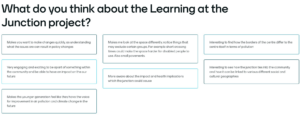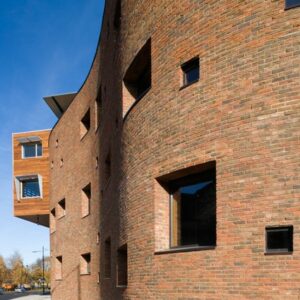‘Provoke that kind of thinking about how space acts upon us, and how it shapes our behaviour but also reflects it’
Jude Parks, Senior Lecturer in Geography and co-coordinator of the Living Lab, reflects on sessions by the junction.
Dr Jude Parks is a Senior Lecturer in Geography and is one of the co-coordinators of the Living Lab. Her research considers sustainability and environmental behaviours, whilst encouraging community engagement. In embedding the Living Lab pedagogy into her Social and Cultural Geography module, she is challenging first-year students to relearn how they perceive the built environments of their everyday.
Parks tells me that each week she has a seminar in the De Grey building, which faces directly out onto the junction. It has ‘been quite useful,’ she says, ‘it almost feels like we’re in a lab.’ During her sessions, she has been taking students outside to collate data on everything at the junction— ‘whether that be things, activities, people, or nonhuman life’— and some students took initiative to record traffic movement and activity levels. In her class, students have been discussing the functionality and physicality of the junction and are starting to categorise their findings. Parks is asking students to ‘produce some sort of a map or diagram of the junction and of the social and cultural forces that are acting on it, and to do that quite creatively.’ She tells me that the voices and experiences of young people do not often get recorded on official maps, so she hopes their works could ‘represent their perspectives, their worlds, or how they use and experience it, but also consider how potentially other groups might as well.’
I remark that interacting with the junction so physically feels odd given that it’s a place we all just pass through, and we start to discuss Marc Augé’s idea of ‘non-places’. I ask Parks what the significance of looking at the politics of ‘non-places’ is. She argues that thinking about the ‘non-places’ that we pass through each day makes us scrutinise ‘our daily routines and activity but [also] what it says more broadly about our society and the bigger problem of climate change.’ This sort of activity ‘provides good thought-provoking material to get the students to think about how space shapes our behaviour, and what space says to us, what it represents for us, what is it that makes this junction a non-place.’ Parks says that to make substantial change here, we need to reconsider the social and cultural forces at play, and how they form the place itself. ‘It’s a really stark example,’ she says, ‘[it will] provoke that kind of thinking about how space acts upon us, and how it shapes our behaviour but also reflects it.’

Through Mentimeter, students express their interest in the project and aspects which have intrigued them so far.
In engaging with the junction on many different physical and social levels, students are working with different frameworks in conjunction with one another. Parks informs me that place-based learning can help visualise these, but it can still prove ‘quite a challenge’ to get the students to ‘unlearn the space and see it in a different way and interpret it.’ Parks tells me that ‘it’s such a routine part of their lives and a familiar space that they have routinely passed though and used, these are first-year students, so they’ve been doing this for most of one semester at least so far’. She explains that these students reflect and interrogate their ‘routines, practices and cultures’, till they become aware of how these can impact their physical surroundings. I note that learning about the physicality of space whilst grappling with social issues, such as environmental racism, may feel confusing to start. Parks replies by saying there is such an importance in looking at ‘how spaces might represent certain groups or reflect certain normativity and hegemonies and marginalise others.’ She uses the example of sexuality at the junction. At first her students couldn’t make the link, seeing it as a deeply un-sexualised place. The class started looking at how signs and signals can be ‘interpret[ed] in relation to heteronormative dimensions of society, even just in things that are passing through, people passing through, relationships, expressions of sexuality in public space’. She emphasises how Social and Cultural Geography requires an intersectional approach, saying, ‘I think the importance will be to get them to think about the connections between social sustainability, social inclusion, and environmental damage.’ Parks encourages her students to challenge the ‘auto-normativity of our society and our cities’, and to form an awareness of the ‘invisible’ environmental impacts that they are exposed to, even on the way to class.
